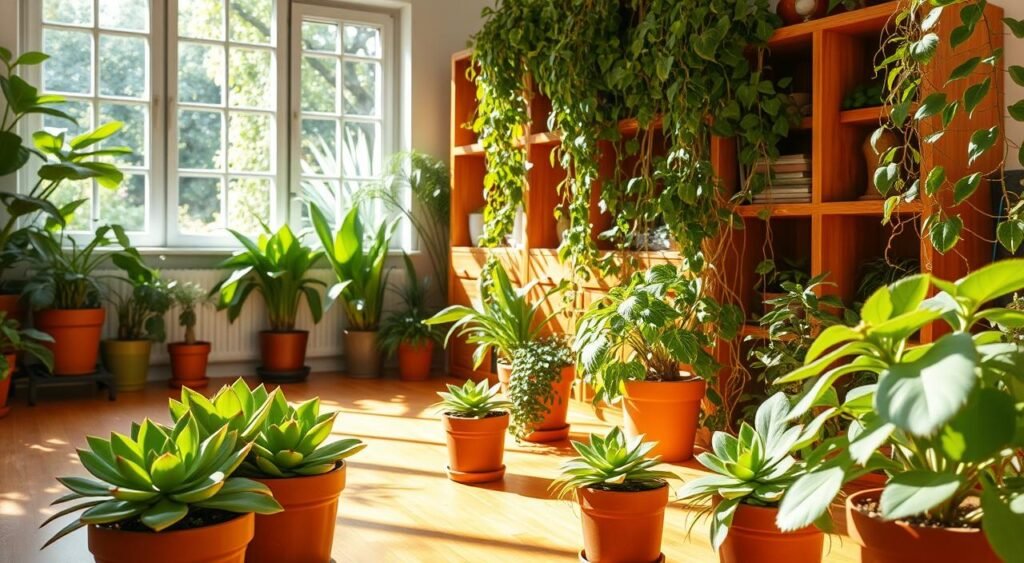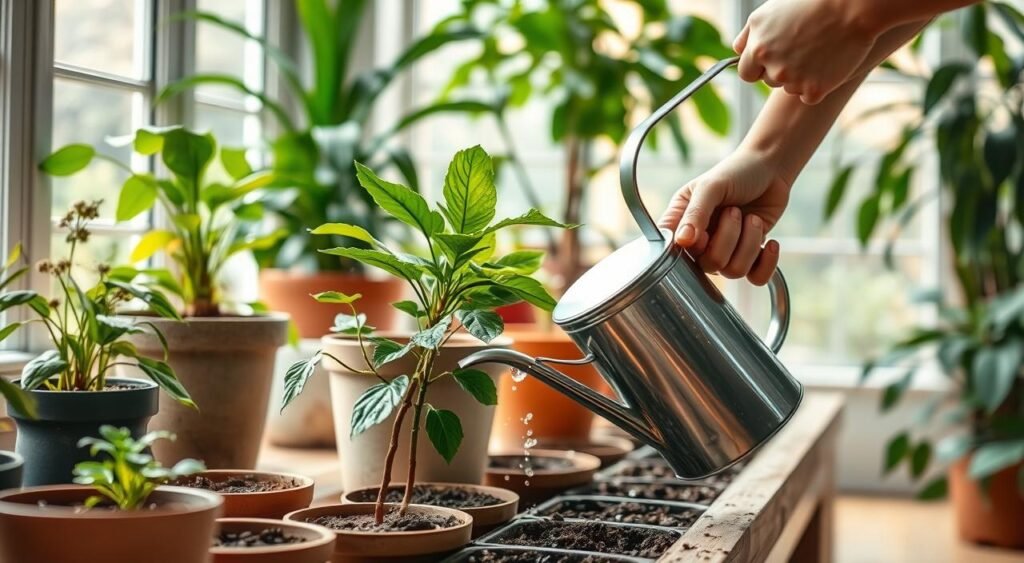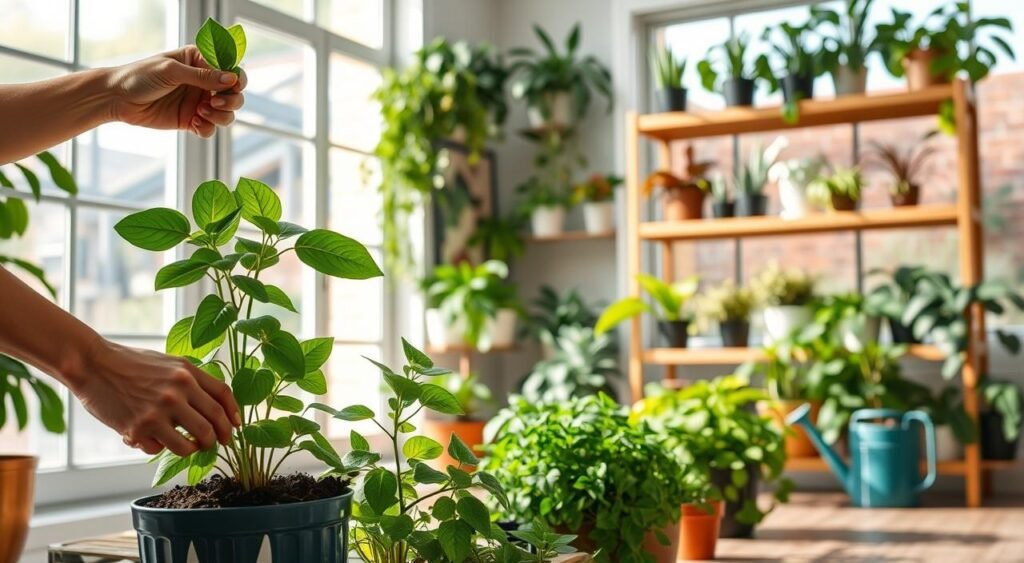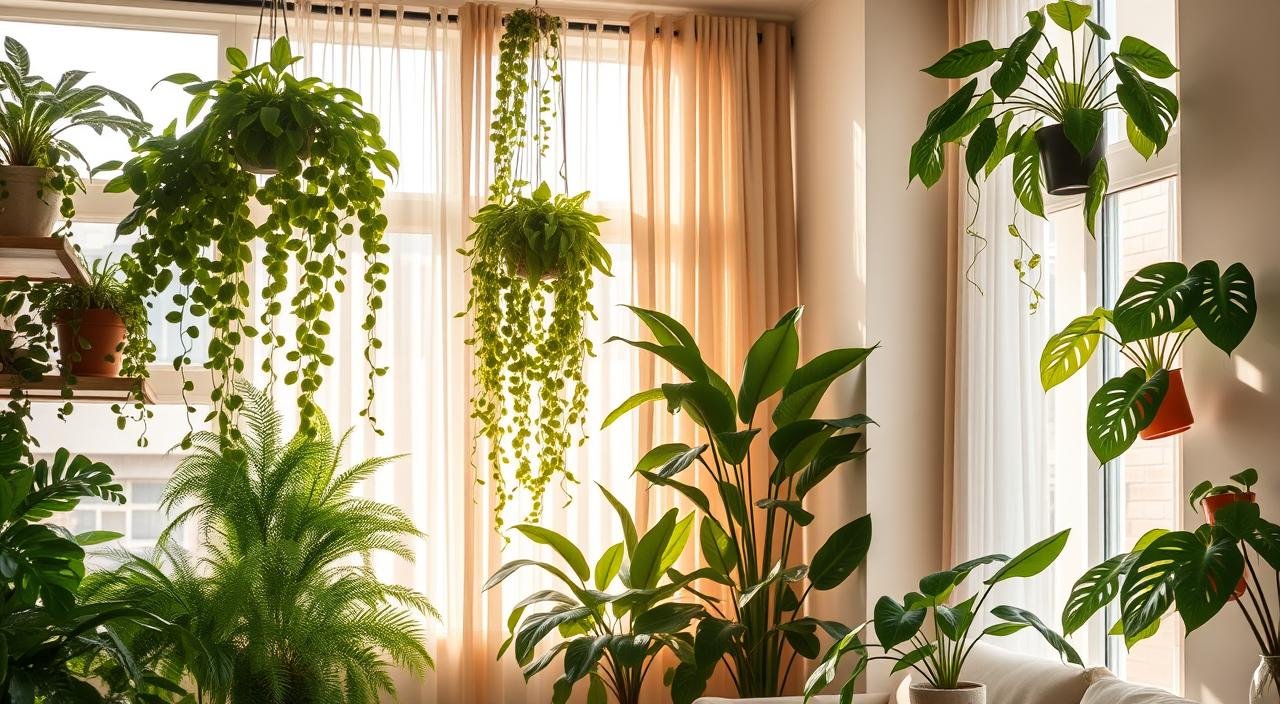Three out of four people say indoor plants improve their mood, and 60% find caring for them relaxing—proof houseplants do more than just decorate1.
With 90% of our time spent indoors2, these green companions offer clean air, stress relief, and vibrant design. This guide explores how to choose, care for, and enjoy houseplants, whether you’re a beginner or a seasoned grower.
Key Takeaways
- Indoor plants boost mood for 78% of owners1.
- Houseplants can raise humidity by 20%, improving air quality1.
- 60% of plant owners find care relaxing1.
- Monstera and Snake Plants are top picks, owned by 35% of enthusiasts1.
- 90% of daily time is spent indoors, making plants essential for well-being2.
What Are Indoor Plants?
Indoor plants, or houseplants, are specially adapted greenery designed to flourish in home environments. Their popularity has skyrocketed, with sales reaching record highs during the pandemic3. These resilient plants thrive in controlled settings, offering beauty and benefits like air purification.
Defining Indoor Plants
Indoor plants differ from outdoor varieties through their ability to grow in artificial light and compact spaces. Most prefer temperatures between 59°F and 77°F (15°C–25°C)3. They’re chosen for their tolerance to varying light and water. Some, like the ZZ Plant, survive droughts and dim corners4.
Popular Types of Indoor Plants
Among the best indoor plants are those balancing beauty and ease. Consider these top picks:
- Snake Plant: Grows up to 12 feet tall and needs watering just once a month4.
- Pothos: Tolerates near darkness and require watering every one to two weeks4.
- Peace Lily: Enhances air quality and blooms in low light, needing weekly watering4.
These varieties thrive with minimal care, making them ideal for beginners. Their popularity stems from adaptability and health benefits, like reducing pollutants by 10–25%3.
Benefits of Having Indoor Plants

Science confirms air-purifying plants and indoor plants improve living spaces. These green companions offer measurable health and environmental perks backed by studies.
Improved Air Quality
NASA’s 1980s research found air-purifying plants like snake plants absorb toxins like formaldehyde, boosting oxygen levels5. While modern tech may outperform a few plants, studies show clusters of greenery still reduce airborne pollutants5. Spider plants and peace lilies are top performers for toxin filtration.
Stress Reduction and Mood Enhancement
A study found indoor gardening lowered stress more than computer tasks5.
Manchester clinics now prescribe potted plants to treat anxiety5. Patients with plants after surgery used 22% less painkillers and left hospitals sooner5. Office spaces with greenery see 12% faster task completion and fewer stress-related sick days5. A 2004 study noted creative problem-solving improves by 15% in plant-filled rooms5. South Korea’s Rural Development Administration advises one small and one large plant per 6m² for best results6.
Increased Humidity Levels
Indoor plants release moisture through transpiration. This natural humidification prevents dry skin and protects wooden furniture. Studies show optimal humidity levels reduce respiratory issues and static electricity in homes5.
Choosing the Right Indoor Plants
Selecting the best indoor plants starts with matching your space and lifestyle. Whether you have limited light or a curious pet, these tips simplify your choices.
Low-Light Indoor Plants
Low light plants thrive in darker spots, making them perfect for rooms with minimal sunlight. The Snake Plant7 tolerates neglect and grows in nearly any condition, while Peace Lilies7 bloom up to 24 inches tall. Pothos vines flourish with just indirect light, needing watering only when soil dries8. These options ensure greenery even in dim corners.
Pet-Friendly Options
For homes with pets, choose non-toxi varieties. Pothos and ZZ plants7 are safe choices. Avoid Rubber Plants, which are toxic if chewed8. Always verify species with ASPCA databases to protect curious pets.
Plants for Beginners
Beginners succeed with forgiving species like Snake Plants7, which store water and tolerate drought. Peace Lilies7 wilt slightly when thirsty, offering visual cues. Pothos8 climb or trail without demanding precision. These low-maintenance picks build confidence for new gardeners.
Essential Care Tips for Indoor Plants

Mastering plant care for your indoor gardening setup starts with understanding each plant’s needs. Proper watering, light, and soil practices ensure they thrive. Let’s break down key techniques to keep your plants healthy.
Watering Techniques
Overwatering kills 90% of houseplants, making it the top threat to plant health9. Use the finger test: stick your finger an inch into the soil. If dry, water thoroughly until liquid drains from the pot’s bottom. Small pots (2–4”) may need watering 1–3 times weekly, while larger pots (6–8”) require it every 1–2 weeks9. Sanseveria, for instance, can go 4 weeks between waterings in low-light areas9. Always use room-temperature water and avoid softened water, which harms roots9.
Proper Lighting Conditions
Light is vital for photosynthesis. Place plants like pothos in bright indirect light, while snake plants tolerate low-light areas. Rotate pots weekly to ensure even growth. South-facing windows offer the strongest light, ideal for sun-lovers like cacti10. If natural light is limited, consider LED grow lights for 12–14 hours daily.
Soil and Fertilization
Choose the right soil mix. Cactus soil drains faster than standard potting mix9, while orchids need bark-based blends. Fertilize during spring and summer growth periods with a balanced 20-20-20 fertilizer diluted to half strength. Apply every 1–2 months and skip winter10. Overfertilizing burns roots, so follow package instructions carefully11.
- Use time-release fertilizer for consistent feeding
- Repot every 1–2 years into slightly larger containers
- Check soil pH levels annually for tropical plants
Regularly inspect leaves and stems for pests like spider mites, which thrive in dry conditions10. Adjust humidity with pebble trays or humidifiers if your home’s air is too dry11.
Common Indoor Plant Pests
Even with proper plant maintenance, pests like scale or spider mites can damage indoor plants. Knowing how to spot infestations ensures healthy growth. Below are key pests and solutions to protect your collection.
Identifying Common Pests
Watch for these signs:
| Pest | Appearance | Host Plants | Damage |
|---|---|---|---|
| Scale | Waxy bumps12 | Citrus, ivy, figs12 | Yellow leaves, honeydew12 |
| Mealybugs | White cottony coatings12 | Coleus, hoya12 | Waxy deposits, stunted growth12 |
| Spider Mites | Microscopic, leave webs12 | Dracaena, schefflera12 | Leaf speckling, bronzing12 |
Natural Pest Control Methods
Try these eco-friendly solutions:
- Neem oil sprays for scale and mealybugs12.
- Insecticidal soap for soft-bodied pests12.
- Rubbing alcohol to remove small infestations13.
- Sticky traps to monitor pests14.
Preventative Measures
Prevent infestations with:
Regular inspections are critical for long-term plant care.
- Isolate new plants for 6 weeks13.
- Weekly checks under leaves13.
- Avoid overwatering to prevent fungus gnats12.
- Use neem oil monthly as a preventive12.
Early action in plant maintenance protects plants from severe damage. Regular checks and quarantine steps reduce risks effectively.
Decorating Your Space with Indoor Plants

Transform your home into a thriving oasis with thoughtful indoor plant decor. The growing popularity of houseplants has led to innovative design solutions, from statement pieces to vertical gardens15. Elevate style while reaping wellness benefits—studies show plants boost mood and air quality16.
Creating a Focal Point
Anchor rooms with bold houseplants like fiddle leaf figs or monstera. Pair with sleek pots in neutral tones to match decor. The LeafJoy® Atrium collection offers curated selections for high-light spaces15. Choose pots that complement your aesthetic:
- Fiddle leaf fig for modern lofts
- Bird of paradise for tropical vibes
- Snake plants for minimalist setups
Utilizing Vertical Space
Maximize small areas with wall-mounted planters or hanging macramac hangers. Scandinavian style thrives with thin-stemmed plants like dracaena, while industrial lofts suit large palm varieties16. Below are design style recommendations:
| Design Style | Plant Picks |
|---|---|
| Modern | Palm, fiddle leaf fig |
| Scandinavian | Dracaena, money plant |
| Industrial | Large palms, succulent clusters |
Grouping Plants for Aesthetic Appeal
Mix plants of varying heights and textures—like pairing a dracaena with trailing pothos. Group 3-5 plants in clusters to create organic arrangements. LeafJoy’s WorkLife® collection pairs well with office groupings15. Pro tip: Leave space between plants to avoid overcrowding.
Follow the “one plant per room” guideline for balanced greenery16. Whether styling a desk or balcony, smart placement turns houseplants into artful fixtures.
Seasonal Care for Indoor Plants
Seasons change how indoor plants grow and thrive. Adjusting routines ensures optimal health. Here’s how to adapt care for each season:
Winter Care Adjustments
During winter, reduce watering by 30%17 as growth slows. Place plants away from cold drafts and use humidifiers to counteract dry indoor air. Many indoor plants benefit from supplemental lighting, like LED grow lights18, to mimic natural daylight. Over 80% of plants thrive with humidity above 40%17, so mist leaves or use pebble trays to maintain moisture.
Spring Growth Boosters
In spring, resume fertilizing every 2-4 weeks19 as growth resumes. Prune dead leaves and repot plants by late August18, ensuring roots have space. Plants like the Bamboo Palm tolerate low light17, making them ideal for dim corners during darker months. Rotate plants weekly to promote even growth17.
Summer Heat Management
Summer requires frequent watering, especially for moisture-loving varieties. Use a humidifying tray to boost humidity by 20-30%17. Protect foliage from direct afternoon sun, and check soil daily during heatwaves. Over 70% of plants need regular dusting to maintain photosynthesis17.
| Season | Key Tips |
|---|---|
| Winter | Reduce watering by 30%17, add humidity |
| Spring | Fertilize every 2-4 weeks19, repot before September18 |
| Summer | Check soil daily, protect from direct sun |
Common Adjustments
- Monitor soil dryness before watering
- Use grow lights for low-light areas18
- Adjust fertilizing based on growth cycles19
Seasonal plant care ensures your indoor plants stay healthy year-round. Observe plant responses to light, temperature, and moisture changes to tailor care precisely.
Repotting Indoor Plants

Repotting is key to maintaining healthy plant care routines. Knowing when and how to repot ensures plants thrive in the right plant pots. Follow these steps to avoid common mistakes and boost growth.
When to Repot
Check plants annually for signs they need repotting. Roots poking through drainage holes or soil drying out within days signal overcrowding20. Plants growing slowly or showing yellow leaves may also need fresh soil. Most indoor plants need repotting every 1–2 years20, but slow-growing varieties can stay in the same pot longer21.
Choosing the Right Pot
Selecting the correct plant pots is critical. Opt for containers with drainage holes to prevent root rot22. Ceramic pots retain moisture well, while plastic is lightweight. Increase pot size by only 1–2 inches to avoid overwatering issues21. A 50/50 mix of orchid and regular potting mix improves drainage22.
Proper Repotting Techniques
Follow these steps to minimize stress:
- Water the plant 24 hours before to loosen roots20.
- Gently remove old soil and trim circling roots with clean shears.
- Place a 2-inch layer of fresh mix in the new pot before adding the plant22.
- Water thoroughly after repotting to settle soil and reduce shock.
Repotting in spring or fall reduces stress during active growth periods22. Always use fresh potting mix instead of garden soil for better aeration22. Avoid overpotting—small plants need only a 1-inch larger container21.
Propagating Indoor Plants
Expanding your houseplants collection doesn’t require a trip to the nursery. Propagation lets you grow new plants from cuttings or divisions, saving money while enjoying the satisfaction of nurturing life. Whether you’re starting with a single stem or dividing a mature plant, mastering propagation techniques enriches any indoor gardening
Common Propagation Methods
Try these proven techniques to multiply your plants:
- Water propagation: Dip cuttings in water, ensuring nodes are submerged. Cut stems at a 45-degree angle to boost root growth23. Change water weekly to maintain oxygen levels23.
- Division: Split overcrowded plants like Sansevieria during spring, aligning with their growth cycle24.
- Leaf cuttings: For succulents, let cuts dry before planting to avoid rot24.
Best Plants for Propagation
Ease and success rate define top choices. Pothos and Philodendron thrive in water, while spider plants naturally send out runners. Rooting hormones can boost success for tougher varieties like ZZ plants23.
Care for New Plants
After roots form, transplant into soil once they reach 3–5 cm in length23. Keep soil moist but not waterlogged for the first two weeks24. Monitor for rot by checking stems for softness. Pothos cuttings release natural hormones that speed up growth in shared water setups23.
Propagation mistakes? Overwatering new roots or using cuttings without nodes are common issues. Patience and clean tools ensure healthy starts. With these steps, even beginners can multiply houseplants effortlessly.
Indoor Plant Maintenance Routines

Effective plant maintenance starts with consistent routines. Daily checks like inspecting leaves for pests or wilting can prevent major issues. Use a fork to gently aerate soil in plastic pots, ensuring roots breathe properly25. Overwatering remains a top killer, affecting 30% of owners25. Here’s how to structure your routine:
- Daily: Check soil moisture with a finger test. Wipe leaves with a damp cloth to boost photosynthesis.
- Weekly: Rotate plants toward light sources. Inspect undersides of leaves for pests. Mist humidity-loving varieties like ferns.
- Monthly: Adjust fertilization schedules. Prune dead foliage. Check pot drainage holes for clogs.
Seasonal adjustments matter too. In winter, reduce watering by 50% for most species26. Spring calls for repotting if roots crowd the pot. Use grow lights for plants needing 8–12 hours of light daily25.
“Consistency in plant care builds thriving ecosystems.”
- Track growth with photos or journals
- Use apps like Plantify or Gardening Tracker for reminders
- Mark bloom cycles and pest outbreaks on calendars
90% of plant owners confirm routines boost plant longevity26. Start small—30 minutes weekly goes a long way. Adjust based on your schedule: even busy owners can thrive by setting calendar alerts. Proper plant maintenance lets Sansevieria or Fiddle-Leaf Figs live over 12 years25. Stick to your plan, and watch your garden flourish.
Resources for Indoor Plant Enthusiasts
Expand your indoor gardening knowledge through trusted resources. Online communities like Reddit’s r/Houseplants and Facebook groups connect growers sharing tips and troubleshooting advice27. These spaces thrive with veteran and new plant parents alike, offering advice tailored to the best indoor plants and common challenges like overwatering27.
“The Houseplant 101 series is a great opportunity to share what I’ve learned with others.”
Online Communities and Forums
- Join forums like The Spruce or Gardenia for curated guides on light requirements and pest control28.
- Follow Instagram accounts like @TheSill or @LeafyJourney for visual care tips28.
Books and Guides
Books like “The New Plant Parent” by Horticulture Magazine explain watering schedules and soil types for popular varieties like Dracaena Marginata27. The Houseplant Care Cheat Sheet outlines ideal light durations (8-12 hours daily) and drainage solutions to prevent root rot28.
Plant Shops and Nurseries
Visit local nurseries like Bloomscape or regional garden centers for healthy specimens. Online retailers like PlantCare.com offer guides on selecting pots with drainage holes28. Over 30% of plant owners struggle with overwatering27, so check store resources for moisture meter recommendations27.
Explore these resources to build a thriving indoor garden. Share your experiences and grow with the community!
Frequently Asked Questions About Indoor Plants
Starting an indoor garden can feel overwhelming, but many challenges have simple solutions. Here’s a quick guide to common concerns faced by plant enthusiasts.
Tips for New Plant Parents
Newcomers often worry about overwatering. Surprisingly, it harms29 indoor plants as much as underwatering. Check soil moisture by poking 1/2 to 1 inch deep—dry soil means it’s time to water29. Choose low-light options like snake plants if your space lacks sun, since 50% of indoor plants thrive in dim conditions30. Always use pots with drainage holes to prevent root rot29.
Troubleshooting Common Issues
Yellow leaves usually signal too little light—move plants to brighter spots29. Brown leaf tips often mean dry air; 60% of gardeners use humidifiers to boost moisture30. Ficus dropping leaves? Stress from relocations or drafty spots often causes this29. To avoid powdery mildew, improve airflow around plants29. For peat-based soils that dry out, soak pots briefly until water drains fully to rehydrate roots29.
Myths and Facts
Myth: All plants need bright light. Fact: Only 20% require direct sun; most prefer indirect light30. Myth: Misting fixes humidity. Fact: It’s temporary—cluster plants or use pebble trays for longer-term solutions30. Myth: Root rot is solely from overwatering. Fact: Poor drainage and compacted soil also contribute29. Prioritize consistent plant maintenance, and remember: learning from mistakes is part of growing a thriving indoor garden.
FAQ
What are the best indoor plants for beginners?
How do indoor plants improve air quality?
Can indoor plants help reduce stress?
What low-light indoor plants can thrive in dim conditions?
How can I tell when to water my indoor plants?
What should I do if my indoor plants have pests?
What are some signs that my indoor plants are happy?
When is the best time to repot my indoor plants?
Are all houseplants safe for pets?
How can I foster a sense of community in indoor gardening?
Source Links
- Intro to House Plants — Lee From America – https://www.leefromamerica.com/blog/introtohouseplants
- Growing Indoor Plants with Success – https://extension.uga.edu/publications/detail.html?number=B1318&title=growing-indoor-plants-with-success
- Houseplant – https://en.wikipedia.org/wiki/Houseplant
- These Hard-to-Kill Houseplants Are Great for Beginners – https://www.goodhousekeeping.com/home/gardening/advice/g1285/hard-to-kill-plants/
- 7 Science-Backed Benefits of Indoor Plants – https://www.healthline.com/health/healthy-home-guide/benefits-of-indoor-plants
- Effects of Indoor Plants on Human Functions: A Systematic Review with Meta-Analyses – https://pmc.ncbi.nlm.nih.gov/articles/PMC9224521/
- Selecting Indoor Plants | University of Maryland Extension – https://extension.umd.edu/resource/selecting-indoor-plants
- 24 Best Indoor Plants – Find Your Perfect Houseplant – Garden Design – https://www.gardendesign.com/houseplants/best-indoor.html
- Houseplants 101 – A Primer for Houseplant Care | Potted – https://pottedstore.com/pages/houseplants-101
- Houseplant Care – https://hort.extension.wisc.edu/articles/houseplant-care/
- 10 Tips to Ensure Happy, Healthy Houseplants – https://www.bhg.com/gardening/houseplants/care/houseplant-care-guide/
- How to Spot 6 Common Houseplant Pests and Get Rid of Them Naturally – https://www.bhg.com/gardening/houseplants/care/common-houseplant-pests/
- Common Houseplant Insects & Related Pests – https://hgic.clemson.edu/factsheet/common-houseplant-insects-related-pests/
- Houseplant pests – Agricultural Biology – https://agsci.colostate.edu/agbio/ipm-pests/houseplant-pests/
- 15 Ideas for Decorating with Plants – Add Life & Color to Any Room – https://www.provenwinners.com/leafjoy/decorating-with-plants
- Styling with plants. How to decorate your home with plants. – https://www.brightsideinteriors.com/how-to-decorate-your-home-with-plants/
- Tips for Caring for Outdoor Plants that I have Brought Inside for the Winter – https://miraclegro.com/en-us/growing-with-martha-stewart/indoor-winter-plant-care-tips.html?srsltid=AfmBOoo9TjLP6YtbQB902h3iyV-4g1UYUcfNngdup20XXhqGbpgSDWq7
- Your Checklist for Fall and Winter Houseplant Care — Seattle’s Favorite Garden Store Since 1924 – Swansons Nursery – https://www.swansonsnursery.com/blog/checklist-for-fall-and-winter-houseplant-care
- How Does Seasonal Change Effect Indoor Plants? – https://plantx.com/blogs/vegan-blogs/how-does-seasonal-change-effect-indoor-plants
- How to Repot a Houseplant the Right Way – https://www.marthastewart.com/8364618/how-to-repot-a-houseplant
- The Sill | How To Pot or Repot Your Houseplants Step By Step – https://www.thesill.com/blogs/care-miscellaneous/plant-care-repotting?srsltid=AfmBOord4qY4Uz8oz7_94eHN9IwetEEbNxDI1rcXArjqLsqD4XjcJ1ER
- Fall Repotting Guide – How to Repot Your Houseplants for Healthier Growth – https://mahoneysgarden.com/fall-repotting-houseplants-guide/
- How to water propagate indoor plants (the simple step-by-step guide with photos) – https://www.lovethatleaf.co.nz/blogs/plant-care-guides/how-to-water-propagate-indoor-plants?srsltid=AfmBOopS1nn_-vEz3QIgkgJEy9MGe67tAYY0tUOlZnsF-y-Cml2GvKxV
- Houseplant 101: How to Easily Propagate Houseplants – City Floral Garden Center – Denver Colorado – https://cityfloralgreenhouse.com/2020/09/houseplant-101-how-to-propagate-houseplants-easily/
- Houseplant Care 101: The Ultimate Guide to Happy & Healthy Indoor Plants – https://homesteadandchill.com/houseplant-care-101/?srsltid=AfmBOooWxrgDqIrGfqrtOEH56rwr0MocOsLaeRkqFlyGLmhtI0Fn15-g
- Essential Plant Care Routines for Houseplants – https://www.apartmentgardensupply.com/blogs/essential-plant-care-propagation-tips/essential-plant-care-routines-for-houseplants
- Houseplant Resource Center | Happy, healthy, vibrant plants! – https://houseplantresourcecenter.com/
- Houseplant Care 101: The Ultimate Guide to Happy & Healthy Indoor Plants – https://homesteadandchill.com/houseplant-care-101/?srsltid=AfmBOoo8Ep9n36XCB9mxMDyOezxc7bS7Khme2YwyyQQffV0yxAX_Ln5F
- What’s Wrong with My Plant? How to Fix 10 Houseplant Problems – https://www.bhg.com/gardening/houseplants/care/how-to-fix-common-houseplant-problems/
- Plant Guide – https://soltech.com/collections/plant-guide?srsltid=AfmBOoqwg2x86A9AjjtZAMcdOZigr5Bwz1CqcXFLNHspKz9O9PHcD7u9

